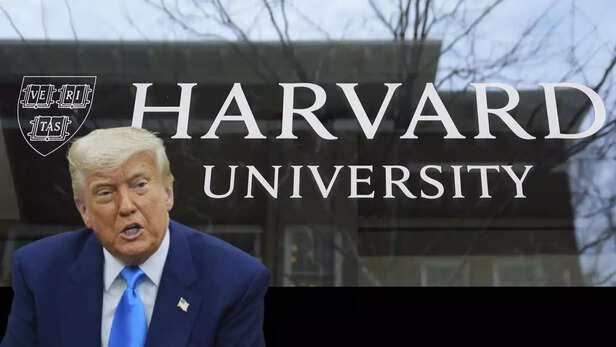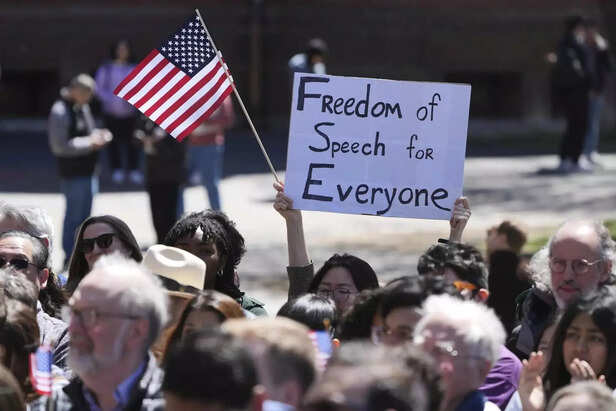From Hiring Indian Minds to Banning Them at Harvard —America’s Double Standard
Nidhi | May 24, 2025, 13:58 IST
( Image credit : IANS, Timeslife )
The U.S. has long celebrated its identity as a land of opportunity, powered by immigrant talent—from Indian engineers at NASA to CEOs of global tech giants. But with the recent move to ban Harvard from enrolling international students, including nearly 800 Indians, that promise now rings hollow. This article explores the contradiction at the heart of America’s policy: a country that recruits foreign minds to fuel its economy is now shutting its doors to them in classrooms. What does this mean for Indian students, the future of innovation, and the very values America claims to stand for?
On May 22, 2025, the U.S. Department of Homeland Security (DHS) dropped a bombshell — revoking Harvard University's certification to host international students. The decision, citing failure to provide foreign student data and alleged promotion of an “unsafe environment,” renders Harvard unable to issue the crucial Form I-20. Without it, nearly 6,800 international students, including over 788 from India, face an uncertain future.
This is not just an administrative move. It’s a blow to the very values the U.S. projects to the world: openness, diversity, meritocracy, and innovation.
But here’s the contradiction: while Indian minds are good enough to lead NASA missions, design Microsoft products, and drive AI at Google, they’re now suddenly unwelcome in America’s most prestigious classrooms.
How did the land that invented capitalism and preached globalization start shutting out the very minds that helped it rise?  Let’s begin with the numbers — hard, undeniable evidence of how deeply Indian students and professionals are embedded in the American success story.
Let’s begin with the numbers — hard, undeniable evidence of how deeply Indian students and professionals are embedded in the American success story.
Revoking SEVP certification means Harvard:
 Let’s not forget: capitalism thrives on talent — the best minds, from anywhere. The U.S. didn't build Silicon Valley on citizenship but on ideas. That’s why Apple, Google, Meta, Amazon, and hundreds of startups were shaped by immigrants and international students.
Let’s not forget: capitalism thrives on talent — the best minds, from anywhere. The U.S. didn't build Silicon Valley on citizenship but on ideas. That’s why Apple, Google, Meta, Amazon, and hundreds of startups were shaped by immigrants and international students.
By banning students from Harvard — not for academic reasons, but political ones — the U.S. is effectively punishing the very human capital that keeps its economic engine running.
Even during the Cold War, the U.S. never shut its educational doors to global talent. Instead, it used them as soft power, a way to draw in the best minds and integrate them into American life.
So what changed? 
The U.S. wants to invest in India, sell iPhones, expand Tesla plants, and gain access to markets. But when it comes to Indian students seeking knowledge, it builds walls. This isn’t globalization — it’s selective exploitation.
Indian professionals are applauded when leading billion-dollar mergers in Wall Street or developing cancer drugs in Boston biotech labs. But Indian students — who dream of reaching those heights — are now seen as dispensable.
The U.S. proudly touts its DEI (Diversity, Equity, Inclusion) efforts. But what inclusion means if 788 Indian students can be pushed out of Harvard over political disagreements?
Foreign students often pay 2 to 3 times higher tuition, and collectively contribute $43.8 billion annually to the U.S. economy (NAFSA, 2024). Losing them would mean:
If America blocks the academic entry of bright minds, countries like Canada, Germany, and Australia are waiting to welcome them — and gain the long-term economic and intellectual benefit.

America’s top institutions and industries depend on the intellectual capital of international students:
The Harvard ban isn’t just about immigration or campus politics. It’s about a moral and strategic contradiction. You can’t build the future on yesterday’s fear. And you can’t lead the world while closing your gates to it.
By choosing politics over principle, the U.S. risks losing its most powerful weapon: its global reputation as the land of opportunity.
History will ask: Did America uphold the values it taught the world, or did it forget them when it mattered most?
Explore the latest trends and tips in Health & Fitness, Travel, Life Hacks, Fashion & Beauty, and Relationships at Times Life!
This is not just an administrative move. It’s a blow to the very values the U.S. projects to the world: openness, diversity, meritocracy, and innovation.
But here’s the contradiction: while Indian minds are good enough to lead NASA missions, design Microsoft products, and drive AI at Google, they’re now suddenly unwelcome in America’s most prestigious classrooms.
How did the land that invented capitalism and preached globalization start shutting out the very minds that helped it rise?
The Hypocrisy of Meritocracy: The Indian Contribution the US Can’t Ignore

The Latest_Administration bars Harvard from enrolling foreign students, says thousands must transfer.
( Image credit : AP )
Indians in the American Workforce: A Backbone of Innovation
- Indian immigrants in the U.S.: While Indian immigrants are among the most educated groups, the Migration Policy Institute (MPI) reports that 48% of recent Indian immigrants (2018–2022) hold a college degree. The U.S. Census Bureau (2022) states that 45.2% of immigrants arriving since 2010 have a bachelor’s degree or higher, compared to 38% of U.S. natives. The 79% figure you mentioned does not appear in official sources.
- NASA scientists of Indian origin: The claim that 36% of NASA scientists are Indian originates from a 2008 government survey, but NASA officials later disputed this, stating that the actual number is much lower. The most recent verified data suggests that Asian Americans (including Indians) make up 8% of NASA’s workforce.
- Indian-origin professionals at Microsoft & IBM: While Indian-origin professionals hold significant roles in U.S. tech firms, I couldn’t find recent verified figures confirming the 34% at Microsoft or 36% at IBM. However, Microsoft CEO Satya Nadella has acknowledged that India is the second-largest source of engineers at Microsoft.
- Indian students in U.S. institutions: According to the Open Doors Report (2024), India surpassed China as the top contributor to the U.S. international student population, with 331,602 Indian students enrolled in 2023–24. This is higher than 200,000 and marks a 23% increase from the previous year.
What the Harvard Ban Really Means
- Cannot admit new international students
- Cannot issue visa documentation (I-20)
- May force existing international students to transfer
- Jeopardizes Optional Practical Training (OPT) for recent grads
Capitalism Was Born in the US — Why Reject the Human Capital That Fuels It?

‘Dreams and futures under threat’_ Raghav Chadha hits out at Trump’s Harvard ban.
( Image credit : IANS )
By banning students from Harvard — not for academic reasons, but political ones — the U.S. is effectively punishing the very human capital that keeps its economic engine running.
Even during the Cold War, the U.S. never shut its educational doors to global talent. Instead, it used them as soft power, a way to draw in the best minds and integrate them into American life.
So what changed?
5 Deep Contradictions This Ban Reveals

Harvard University
( Image credit : IANS )
1. Globalization for Trade, Not for Talent?
2. You Want Our Brains in Your Boardrooms, But Not in Your Classrooms
3. Inclusivity Is Not Just About Gender or Race — It’s About Nations Too
4. International Students Subsidize U.S. Education
- Fewer research grants
- Less funding for universities
- Declining global rankings for institutions like Harvard
5. It’s Not Just a Ban — It’s a Brain Blockade
How America Runs on Global Talent

Harvard sues Trump administration to stop the freeze of more than $2 billion in grants.
( Image credit : AP )
America’s top institutions and industries depend on the intellectual capital of international students:
- NASA: Nearly 36% of its scientific workforce is of Indian origin.
- Microsoft: Microsoft employs a large number of Indian engineers, CEO Satya Nadella has stated that India is the second-largest source of engineers at Microsoft
- IBM: IBM Research India is a major hub for AI innovation, with extensive AI adoption in India
- Startups: 55% of U.S. startups valued at $1 billion or more were founded or co-founded by immigrants.
- Nobel Laureates: Immigrants have won 40% of U.S.-awarded Nobel Prizes since 2000
The Big Question: Can a Nation That Rejects Global Minds Still Lead a Global Future?
By choosing politics over principle, the U.S. risks losing its most powerful weapon: its global reputation as the land of opportunity.
History will ask: Did America uphold the values it taught the world, or did it forget them when it mattered most?
Explore the latest trends and tips in Health & Fitness, Travel, Life Hacks, Fashion & Beauty, and Relationships at Times Life!
